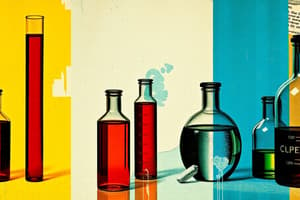Podcast
Questions and Answers
What color does blue litmus paper turn in an acidic solution?
What color does blue litmus paper turn in an acidic solution?
Red
What is the chemical formula for hydrochloric acid?
What is the chemical formula for hydrochloric acid?
HCl
Name one common laboratory acid other than hydrochloric acid.
Name one common laboratory acid other than hydrochloric acid.
Sulfuric acid
What type of indicator changes its odor in acidic or basic solutions?
What type of indicator changes its odor in acidic or basic solutions?
What color does red litmus paper turn in a basic solution?
What color does red litmus paper turn in a basic solution?
Give an example of a common base, other than sodium hydroxide.
Give an example of a common base, other than sodium hydroxide.
What is the chemical formula for acetic acid?
What is the chemical formula for acetic acid?
Is ammonium hydroxide ($NH_4OH$) an acid or a base?
Is ammonium hydroxide ($NH_4OH$) an acid or a base?
What is the effect of an acid on methyl orange indicator?
What is the effect of an acid on methyl orange indicator?
What is the effect of a base on phenolphthalein indicator?
What is the effect of a base on phenolphthalein indicator?
How can you distinguish between three test tubes containing distilled water, an acidic solution, and a basic solution, respectively, using only red litmus paper?
How can you distinguish between three test tubes containing distilled water, an acidic solution, and a basic solution, respectively, using only red litmus paper?
A student tests a solution with red litmus paper and observes no change. What can they conclude about the solution's nature?
A student tests a solution with red litmus paper and observes no change. What can they conclude about the solution's nature?
Explain how olfactory indicators can be used to differentiate between hydrochloric acid (HCl) and sodium hydroxide (NaOH) solutions.
Explain how olfactory indicators can be used to differentiate between hydrochloric acid (HCl) and sodium hydroxide (NaOH) solutions.
If a solution changes methyl orange indicator from orange to red, what does this indicate about the solution?
If a solution changes methyl orange indicator from orange to red, what does this indicate about the solution?
A lab technician accidentally mixed hydrochloric acid ($HCl$) and sodium hydroxide ($NaOH$). How can they determine if the resulting solution is neutral, acidic, or basic using only phenolphthalein?
A lab technician accidentally mixed hydrochloric acid ($HCl$) and sodium hydroxide ($NaOH$). How can they determine if the resulting solution is neutral, acidic, or basic using only phenolphthalein?
You have two unknown solutions, one acidic and one basic. Using only the chopped onion test, describe how you would identify each solution.
You have two unknown solutions, one acidic and one basic. Using only the chopped onion test, describe how you would identify each solution.
A student tests a solution with both red litmus paper and blue litmus paper. The red litmus turns blue, and the blue litmus remains blue. What can the student conclude about the solution?
A student tests a solution with both red litmus paper and blue litmus paper. The red litmus turns blue, and the blue litmus remains blue. What can the student conclude about the solution?
Explain why it is important to use a variety of indicators, rather than just one, when determining the acidity or basicity of a solution.
Explain why it is important to use a variety of indicators, rather than just one, when determining the acidity or basicity of a solution.
If you add a drop of phenolphthalein to calcium hydroxide [$Ca(OH)_2$], what color change would you expect to see and why?
If you add a drop of phenolphthalein to calcium hydroxide [$Ca(OH)_2$], what color change would you expect to see and why?
A solution is tested with methyl orange and the solution turns yellow. Describe the nature of the solution.
A solution is tested with methyl orange and the solution turns yellow. Describe the nature of the solution.
Explain how the presence of a weak acid like acetic acid ($CH_3COOH$) affects the degree of dissociation of a strong acid like hydrochloric acid (HCl) in the same solution. What is this phenomenon called?
Explain how the presence of a weak acid like acetic acid ($CH_3COOH$) affects the degree of dissociation of a strong acid like hydrochloric acid (HCl) in the same solution. What is this phenomenon called?
Imagine you have a mixture of three unknown solutions: hydrochloric acid (HCl), sodium hydroxide (NaOH), and sodium chloride (NaCl). You only have access to red litmus paper. Describe a step-by-step procedure to identify each solution.
Imagine you have a mixture of three unknown solutions: hydrochloric acid (HCl), sodium hydroxide (NaOH), and sodium chloride (NaCl). You only have access to red litmus paper. Describe a step-by-step procedure to identify each solution.
If a solution of $NH_4Cl$ (ammonium chloride) is added to a solution of $NH_4OH$ (ammonium hydroxide), how does the pH of the $NH_4OH$ solution change, and why?
If a solution of $NH_4Cl$ (ammonium chloride) is added to a solution of $NH_4OH$ (ammonium hydroxide), how does the pH of the $NH_4OH$ solution change, and why?
Explain how an olfactory indicator like vanilla extract would behave differently in a strong acid versus a strong base. What chemical process causes this difference?
Explain how an olfactory indicator like vanilla extract would behave differently in a strong acid versus a strong base. What chemical process causes this difference?
You have two solutions: one is a strong acid and the other is a weak acid. Both have the same pH. Explain why the strong acid will cause a greater change in pH when diluted compared to the weak acid.
You have two solutions: one is a strong acid and the other is a weak acid. Both have the same pH. Explain why the strong acid will cause a greater change in pH when diluted compared to the weak acid.
How does the strength of an acid or base relate to its conductivity in solution, and why might this relationship not always hold true?
How does the strength of an acid or base relate to its conductivity in solution, and why might this relationship not always hold true?
Describe what would theoretically happen to the color of methyl orange indicator ($pK_a \approx 3.4$) in a solution buffered at pH 7.0.
Describe what would theoretically happen to the color of methyl orange indicator ($pK_a \approx 3.4$) in a solution buffered at pH 7.0.
Explain why, at the same molar concentration, sulphuric acid ($H_2SO_4$) can neutralize twice the amount of sodium hydroxide (NaOH) compared to hydrochloric acid (HCl).
Explain why, at the same molar concentration, sulphuric acid ($H_2SO_4$) can neutralize twice the amount of sodium hydroxide (NaOH) compared to hydrochloric acid (HCl).
You have a solution that turns blue litmus red but does not react with zinc metal. What does this suggest about the acidic properties of the solution?
You have a solution that turns blue litmus red but does not react with zinc metal. What does this suggest about the acidic properties of the solution?
Using Le Chatelier's principle, predict the effect of increasing the temperature on the ionization of water ($H_2O \rightleftharpoons H^+ + OH^-$). Given that the process is endothermic.
Using Le Chatelier's principle, predict the effect of increasing the temperature on the ionization of water ($H_2O \rightleftharpoons H^+ + OH^-$). Given that the process is endothermic.
Consider a scenario where you have synthesized a novel amphoteric molecule with unknown acid dissociation constants ($pK_a$ values). Describe a multi-step experimental procedure, including specific techniques and calculations, to determine the distinct $pK_a$ values associated with this molecule in an aqueous solution at $25^{\circ}C$.
Consider a scenario where you have synthesized a novel amphoteric molecule with unknown acid dissociation constants ($pK_a$ values). Describe a multi-step experimental procedure, including specific techniques and calculations, to determine the distinct $pK_a$ values associated with this molecule in an aqueous solution at $25^{\circ}C$.
You are tasked with designing a buffer system that maintains a pH of 7.4 under physiological conditions but must also function effectively at $4^{\circ}C$ (refrigeration temperature). Explain how temperature affects the ionization constant ($K_a$) of weak acids, and detail a method to adjust the buffer composition to compensate for these temperature-induced changes, ensuring optimal buffering capacity at both temperatures.
You are tasked with designing a buffer system that maintains a pH of 7.4 under physiological conditions but must also function effectively at $4^{\circ}C$ (refrigeration temperature). Explain how temperature affects the ionization constant ($K_a$) of weak acids, and detail a method to adjust the buffer composition to compensate for these temperature-induced changes, ensuring optimal buffering capacity at both temperatures.
Aqueous solutions of $FeCl_3$ are acidic. Explain the chemical processes involved at a molecular level, using appropriate chemical equations, which results in the solution having a pH less than 7. Furthermore, explain how increasing the concentration of $FeCl_3$ would affect the pH.
Aqueous solutions of $FeCl_3$ are acidic. Explain the chemical processes involved at a molecular level, using appropriate chemical equations, which results in the solution having a pH less than 7. Furthermore, explain how increasing the concentration of $FeCl_3$ would affect the pH.
Consider a scenario: A research lab has discovered a new organic compound. Initial tests indicate it behaves as a weak base. Describe a comprehensive experimental procedure, including specific analytical techniques, to determine the base dissociation constant ($K_b$) of this compound. Detail the calculations necessary to derive $K_b$ from the experimental data.
Consider a scenario: A research lab has discovered a new organic compound. Initial tests indicate it behaves as a weak base. Describe a comprehensive experimental procedure, including specific analytical techniques, to determine the base dissociation constant ($K_b$) of this compound. Detail the calculations necessary to derive $K_b$ from the experimental data.
Explain, using principles of chemical thermodynamics, why strong acids completely dissociate in aqueous solution while weak acids only partially dissociate. Include in your explanation the role of entropy and enthalpy in determining the extent of dissociation, and how the hydration of ions influences the process.
Explain, using principles of chemical thermodynamics, why strong acids completely dissociate in aqueous solution while weak acids only partially dissociate. Include in your explanation the role of entropy and enthalpy in determining the extent of dissociation, and how the hydration of ions influences the process.
A solution is prepared by mixing 50.0 mL of 0.20 M $NH_3$ with 50.0 mL of 0.10 M HCl. Calculate the pH of the resulting solution, given that the $K_b$ for $NH_3$ is $1.8 imes 10^{-5}$.
A solution is prepared by mixing 50.0 mL of 0.20 M $NH_3$ with 50.0 mL of 0.10 M HCl. Calculate the pH of the resulting solution, given that the $K_b$ for $NH_3$ is $1.8 imes 10^{-5}$.
Describe an experimental setup to measure the enthalpy change of neutralization when a strong acid reacts with a strong base in a calorimeter. Detail the steps required for accurate data collection and explain how heat loss to the surroundings can be minimized. Further, explain how you would calculate the enthalpy change of neutralization from the experimental data.
Describe an experimental setup to measure the enthalpy change of neutralization when a strong acid reacts with a strong base in a calorimeter. Detail the steps required for accurate data collection and explain how heat loss to the surroundings can be minimized. Further, explain how you would calculate the enthalpy change of neutralization from the experimental data.
How do the Hammett acidity function ($H_0$) and Z acidity function provide a more accurate measure of acidity in highly concentrated acid solutions compared to pH? Explain the theoretical basis for these acidity functions, and describe an experimental method to determine the $H_0$ value of a given superacid system.
How do the Hammett acidity function ($H_0$) and Z acidity function provide a more accurate measure of acidity in highly concentrated acid solutions compared to pH? Explain the theoretical basis for these acidity functions, and describe an experimental method to determine the $H_0$ value of a given superacid system.
You have a mixture containing a strong acid, a weak acid, and a neutral salt. Design a sequential titration procedure using both acid-base titrants and selective precipitation reactions to quantify each component independently. Explain the chemical principles behind each step, including appropriate indicator choices and pH ranges for accurate endpoint determination.
You have a mixture containing a strong acid, a weak acid, and a neutral salt. Design a sequential titration procedure using both acid-base titrants and selective precipitation reactions to quantify each component independently. Explain the chemical principles behind each step, including appropriate indicator choices and pH ranges for accurate endpoint determination.
Explain the concept of superacidity. Provide four examples - with chemical formulas - of superacids, and delineate the criteria used to classify these substances as such. Compare and contrast the properties and applications of two specific superacids, highlighting their strengths and weaknesses.
Explain the concept of superacidity. Provide four examples - with chemical formulas - of superacids, and delineate the criteria used to classify these substances as such. Compare and contrast the properties and applications of two specific superacids, highlighting their strengths and weaknesses.
Using only red litmus paper, how can you distinguish between distilled water, an acidic solution, and a basic solution?
Using only red litmus paper, how can you distinguish between distilled water, an acidic solution, and a basic solution?
What is the purpose of using indicators like litmus paper, phenolphthalein and methyl orange?
What is the purpose of using indicators like litmus paper, phenolphthalein and methyl orange?
Explain what olfactory indicators are and provide an example from the text.
Explain what olfactory indicators are and provide an example from the text.
Write the chemical formula for sulfuric acid.
Write the chemical formula for sulfuric acid.
List three common laboratory acids mentioned in the text.
List three common laboratory acids mentioned in the text.
What would you expect to observe if you tested a solution of calcium hydroxide [$Ca(OH)_2$] with red litmus paper?
What would you expect to observe if you tested a solution of calcium hydroxide [$Ca(OH)_2$] with red litmus paper?
Imagine you have a solution that remains colorless when tested with both red litmus and blue litmus paper. What can you conclude about the solution?
Imagine you have a solution that remains colorless when tested with both red litmus and blue litmus paper. What can you conclude about the solution?
Describe a procedure to identify if an unknown solution is either $H_2SO_4$ or $CH_3COOH$ using only the materials listed in Activity 2.1. What observations would lead you to differentiate them?
Describe a procedure to identify if an unknown solution is either $H_2SO_4$ or $CH_3COOH$ using only the materials listed in Activity 2.1. What observations would lead you to differentiate them?
Propose a modification to Activity 2.2 that could allow for a more quantitative measurement of acidity or basicity using the onion olfactory indicator. What additional materials would you need?
Propose a modification to Activity 2.2 that could allow for a more quantitative measurement of acidity or basicity using the onion olfactory indicator. What additional materials would you need?
You have solutions of $NaOH$ and $NH_4OH$ of equal concentration. Without using any additional indicators or laboratory equipment, describe a method to qualitatively determine which solution is more basic, relying only on your sense of smell after controlled exposure to air. Explain the chemical principle behind your observation.
You have solutions of $NaOH$ and $NH_4OH$ of equal concentration. Without using any additional indicators or laboratory equipment, describe a method to qualitatively determine which solution is more basic, relying only on your sense of smell after controlled exposure to air. Explain the chemical principle behind your observation.
How can red litmus paper be used to differentiate between distilled water, an acidic solution, and a basic solution?
How can red litmus paper be used to differentiate between distilled water, an acidic solution, and a basic solution?
List three common acids that might be found in a school science laboratory.
List three common acids that might be found in a school science laboratory.
What is an olfactory indicator?
What is an olfactory indicator?
Describe a simple method to prepare olfactory indicator strips using common household items.
Describe a simple method to prepare olfactory indicator strips using common household items.
If a solution turns blue litmus paper red, is it acidic or basic?
If a solution turns blue litmus paper red, is it acidic or basic?
What color change would you expect to see when you add phenolphthalein to a basic solution?
What color change would you expect to see when you add phenolphthalein to a basic solution?
Explain why it is important to use a variety of indicators when testing unknown solutions.
Explain why it is important to use a variety of indicators when testing unknown solutions.
A student tests a solution with both red litmus paper and blue litmus paper. The red litmus paper turns blue, and the blue litmus paper remains blue. What can the student conclude about the solution?
A student tests a solution with both red litmus paper and blue litmus paper. The red litmus paper turns blue, and the blue litmus paper remains blue. What can the student conclude about the solution?
Imagine you have a solution that is known to be either a very weak acid or a very weak base. Neither red nor blue litmus paper changes color noticeably when dipped into the solution. Suggest an alternative indicator that might provide a clearer result, and explain why it might be more suitable.
Imagine you have a solution that is known to be either a very weak acid or a very weak base. Neither red nor blue litmus paper changes color noticeably when dipped into the solution. Suggest an alternative indicator that might provide a clearer result, and explain why it might be more suitable.
You have three unknown solutions: one is $0.1 M$ HCl, another is $0.1 M$ NaOH, and the third is $0.1 M$ NaCl. You only have access to a pH meter that reads only integer values (no decimal places) and methyl orange indicator. Describe a procedure to identify each solution using only these tools, given the limitations of the pH meter.
You have three unknown solutions: one is $0.1 M$ HCl, another is $0.1 M$ NaOH, and the third is $0.1 M$ NaCl. You only have access to a pH meter that reads only integer values (no decimal places) and methyl orange indicator. Describe a procedure to identify each solution using only these tools, given the limitations of the pH meter.
Flashcards
Red Litmus Paper
Red Litmus Paper
A type of paper that turns blue in basic solutions and remains red in acidic solutions.
Acidic Solution
Acidic Solution
A solution with a pH less than 7 that donates protons (H+) in a reaction.
Basic Solution
Basic Solution
A solution with a pH greater than 7 that accepts protons (H+) in a reaction.
Indicators
Indicators
Signup and view all the flashcards
Olfactory Indicators
Olfactory Indicators
Signup and view all the flashcards
Hydrochloric Acid (HCl)
Hydrochloric Acid (HCl)
Signup and view all the flashcards
Sodium Hydroxide (NaOH)
Sodium Hydroxide (NaOH)
Signup and view all the flashcards
Phenolphthalein
Phenolphthalein
Signup and view all the flashcards
Methyl Orange
Methyl Orange
Signup and view all the flashcards
Activities in Testing Solutions
Activities in Testing Solutions
Signup and view all the flashcards
Testing with Red Litmus Paper
Testing with Red Litmus Paper
Signup and view all the flashcards
Testing Color Change
Testing Color Change
Signup and view all the flashcards
Color with Blue Litmus Paper
Color with Blue Litmus Paper
Signup and view all the flashcards
Conducting Acid-Base Experiments
Conducting Acid-Base Experiments
Signup and view all the flashcards
Phenolphthalein Color Change
Phenolphthalein Color Change
Signup and view all the flashcards
Nitric Acid (HNO3)
Nitric Acid (HNO3)
Signup and view all the flashcards
Indicators Provided in Experiments
Indicators Provided in Experiments
Signup and view all the flashcards
Identifying Test Tubes
Identifying Test Tubes
Signup and view all the flashcards
Acids
Acids
Signup and view all the flashcards
Bases
Bases
Signup and view all the flashcards
pH Scale
pH Scale
Signup and view all the flashcards
Testing with Indicators
Testing with Indicators
Signup and view all the flashcards
Hydrochloric Acid
Hydrochloric Acid
Signup and view all the flashcards
Sodium Hydroxide
Sodium Hydroxide
Signup and view all the flashcards
Color Change Observations
Color Change Observations
Signup and view all the flashcards
Activity with Onions
Activity with Onions
Signup and view all the flashcards
Phenolphthalein Indicator
Phenolphthalein Indicator
Signup and view all the flashcards
Acidic Solutions Testing
Acidic Solutions Testing
Signup and view all the flashcards
Basic Solutions Testing
Basic Solutions Testing
Signup and view all the flashcards
Types of Acids
Types of Acids
Signup and view all the flashcards
Sulfuric Acid (H2SO4)
Sulfuric Acid (H2SO4)
Signup and view all the flashcards
Acetic Acid (CH3COOH)
Acetic Acid (CH3COOH)
Signup and view all the flashcards
Indicators in Experiments
Indicators in Experiments
Signup and view all the flashcards
Distilled Water
Distilled Water
Signup and view all the flashcards
Color Change Indicators
Color Change Indicators
Signup and view all the flashcards
Phenolphthalein Observations
Phenolphthalein Observations
Signup and view all the flashcards
Using Onions as Indicators
Using Onions as Indicators
Signup and view all the flashcards
Chemical Properties of Acids
Chemical Properties of Acids
Signup and view all the flashcards
Chemical Properties of Bases
Chemical Properties of Bases
Signup and view all the flashcards
Lab Activities for Testing
Lab Activities for Testing
Signup and view all the flashcards
Study Notes
Acids and Bases in the Laboratory
- Collect solutions like hydrochloric acid (HCl), sulphuric acid (H₂SO₄), nitric acid (HNO₃), acetic acid (CH₃COOH), sodium hydroxide (NaOH), calcium hydroxide [Ca(OH)₂], potassium hydroxide (KOH), magnesium hydroxide [Mg(OH)₂], and ammonium hydroxide (NH₄OH).
- Use indicators like red litmus, blue litmus, phenolphthalein, and methyl orange to test solutions.
- Observe color changes of indicators for each solution.
- Record observations in a table (e.g., Table 2.1).
- Solutions can be tested with indicators to determine if they are acidic or basic.
- Use a watch glass to apply the solutions to the indicators.
- Use red litmus paper to identify the contents of test tubes containing an acidic solution or a basic solution, if you're only provided with red litmus paper.
- Tabulate your observations.
Olfactory Indicators
- Some substances change odor in acidic or basic media.
- These are called olfactory indicators.
- Onions can be used as an example of an olfactory indicator.
- Onion strips can be stored in a plastic bag overnight in the fridge with a clean cloth.
- The cloth can be used to discern whether a substance is an acid or a base, by placing drops of dilute hydrochloric acid (HCl) or dilute sodium hydroxide (NaOH).
- This method uses the cloth strips as indicators to detect changes in odor.
Studying That Suits You
Use AI to generate personalized quizzes and flashcards to suit your learning preferences.




